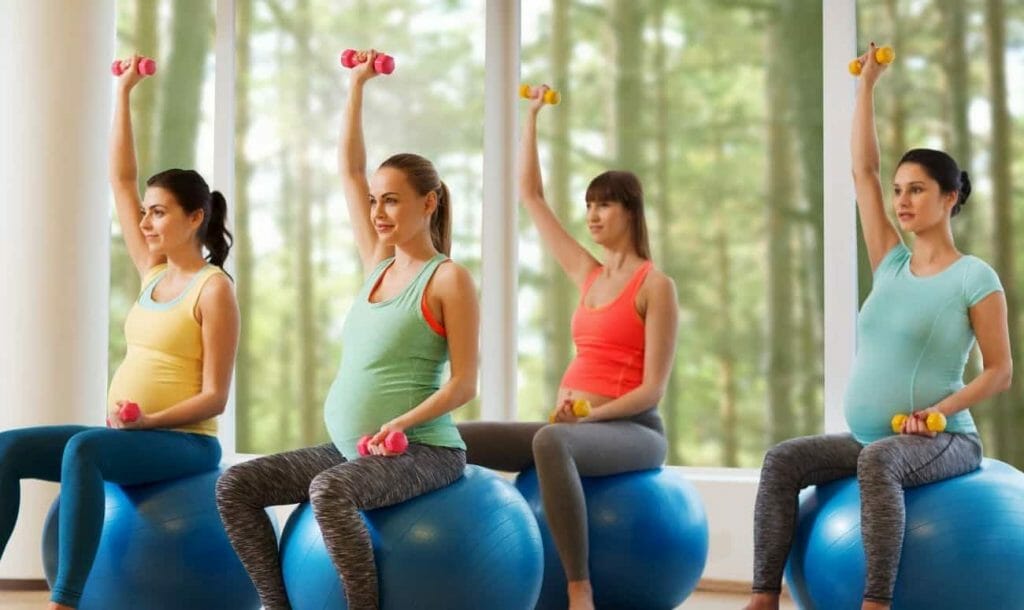Being pregnant is such a magical time, a time that seems perfect for you to sit back and relax and let the beauty of nature unfold around you. The changes that take place after pregnancy can leave you feeling exhausted and tired and your back might hurt from carrying around the extra weight as well. But on the contrary, if you aren’t facing any pregnancy complications, sitting around idle won’t truly help you.
Women are often flooded with unsolicited advice about their bodies and how they can manage their pregnancies uncomplicatedly. Myths that start floating around as soon as a woman becomes pregnant are hard to escape. Rumours like exercise can deprive a foetus of oxygen, pregnant women need to stay under a certain heart rate or that body-moving exercises are dangerous for your pregnancy go all around.
To give you an honest perspective on these myths, we’d like to clear that exercising during pregnancy is ultimately beneficial for the mom and the baby. There’s a lot of research that backs this fact and it’s also been proven that regular exercise prevents gestational diabetes, high blood pressure and preeclampsia in pregnant women. It also improves their psychological well-being, helps the baby develop a healthy heart and reduces their risk of chronic disease later in life.
But we’d like to also tell you that these exercises need to be done under expert supervision and in moderate intensity. While it’s great working out while pregnant, following precautions can help keep you and your baby safe.
Benefits of exercise during pregnancy
Working out during pregnancy needs to depend largely on your health levels, which trimester you’re in, how good your fitness levels are and how you’re feeling during your pregnancy. But we can say with certainty that going to the gym while pregnant is nothing to be embarrassed about. In fact, it’s one of the best places to be while pregnant.
Finding the motivation to exercise regularly can be difficult at a time when your body is exhausted and tired but the payoff is massive. Working out regularly can minimise aches and constipation, improve your sleep quality and reduce your risk of depression. It can even help you have a shorter, less complicated labour while also helping your bounce back faster after delivery. If that’s not enough, exercise releases the happy hormones or endorphins in your body. This regulates mood changes or the huge influx of extra progesterone and estrogen during pregnancy.
Will working out harm the baby?
It’s natural to worry about the safety of your child, especially battling anxiety about the possibility of a miscarriage. Despite the myths that say that strenuous exercise harms the baby, there is no real evidence that links working out to miscarriage.
However, if you’re early in your pregnancy, it’s safe to keep your body temperature low by staying hydrated, not exercising outdoors in the heat and avoiding heart-rate spiking exercises that’ll have you huffing and puffing.
Best exercises to do while pregnant
If there are prenatal classes in your locality then the first thing you need to do is sign up. Not only are the workouts modified for your safety, health and comfort, but the connection you build with fellow moms-to-be can also help you bond over stressful symptoms like heartburn, swollen feet and a struggling bladder. It’ll make you realise that you’re not alone in this and you can even share post-pregnancy tips with mothers who’ll go through the same things as you.
If you don’t have access to prenatal classes, going about working out is perfectly normal as long as you be mindful of how your body reacts to exercise. Pay attention to how your body feels, your body temperature, your heart rate and your breath. Limit your intensity and stay within the normal range of motion required for pregnant women. Make sure that your instructor is informed about your pregnancy and can help you with the required modifications.
Here are some of the most common classes you can take while pregnant:
Pilates
Pilates is great when you’re looking to maintain your abdominal muscle tone. This will help pregnant women support their growing belly, minimise backache and improve energy and core strength required for pushing during delivery. However, avoid mat exercises once you’ve crossed your first trimester. If you still wish to do them, add a foam roller spine support to keep your head higher than your belly.
Yoga
Prenatal yoga is wonderful for improving core strength and flexibility. The gentle movements and training of the mind to be aware of the body and breath can inculcate a sense of peace, almost a therapeutic calm.
Post your first trimester, we recommend avoiding twists and movements that can stretch your belly and exercises that require you to lie flat on your back or belly.
Water Aerobics
The fluidity of the water is an amazing way to move aching joints and keep your body temperature cool. And you won’t even fear the thought of tripping and falling. But remember to wear slip-proof shoes so that you don’t lose your balance.
Strength Training
Pregnancy releases relaxin into your body, a hormone that loosens ligaments to ready your body for labour. But strength exercises are safe when done at a low-to-moderate level. Free weight and body-weight exercises like push-ups and squats are safe to do while pregnant. And no, squatting won’t push you into labour. If you’d like to exercise your abs, avoid lying on your back and instead opt for standing ab exercises.
Cardio
If you loved being active before pregnancy, continue to do so while pregnant as well. If you weren’t as active, choose this time to introduce the habit into your lifestyle. For cardio, you can start with a 30-minute walk every day. Either on the treadmill or in a park, amidst nature. But always pay attention to your body and what it’s telling you. Scale back on the intensity and keep an eye on your heart rate. Remember though that blood volume increases during pregnancy and your resting heart rate could be higher than normal.
Exercises to avoid during pregnancy
Sports that carry a higher risk of falling or injury to the abdomen: These include gymnastics, skiing, skating, tennis, horseback riding, outdoor cycling, basketball, soccer, etc.
Exercises that involve lying on your back: Lying on your back for long periods can cause the growing uterus to push down on the veins that deliver blood, leading to reduced blood flow.
Abdominal exercises: Full sit-ups, leg lifts can pull at the abdomen and stretch your belly. It’s best to avoid these.
Hot yoga or exercise in hot weather: Being in an environment or doing exercises that raise body temperature more than 1.5°F causes the blood to be shunted away from the uterus. This can lead to feeling light-headed and nauseous.
Rigorous jumping or bounding: It’s best to avoid exercises that put a strain on your body and belly. It’s better to opt for workouts that help you stay balanced and keep you safe and comfortable.
Read more: Meditation For Kids: Teach Your Child Mindfulness
Like & Follow ThinkRight.me on Facebook, Instagram, Twitter, and Telegram to stay connected.






























